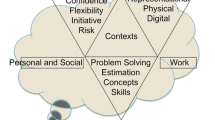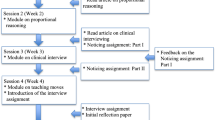Abstract
This paper reports a study about how a teacher educator shared knowledge with teachers when they worked together to implement mathematical problem posing (MPP) in the classroom. It includes feasible methods for getting practitioners to use research-based tasks aligned to the curriculum in order to encourage children to pose mathematical problems. Techniques, challenges, and strategies of implementing an MPP focus were also reported.


Similar content being viewed by others
References
Bieda, K. N. (2010). Enacting proof-related tasks in middle school mathematics: Challenges and opportunities. Journal for Research in Mathematics Education, 41(4), 351–382.
Brown, S. I., & Walter, M. I. (1983). The art of problem posing. Philadelphia: Franklin Institute Press.
Cooney, T. J., & Krainer, K. (1996). In-service mathematics teacher education: The importance of listening. In A. Bishop et al. (Eds.), International handbook of mathematics education (pp. 1155–1185). The Netherlands: Kluwer.
Creswell, J. (2009). Research design: Qualitative, quantitative, and mixed methods approaches. New York: Sage.
Ellerton, N. F. (1986). Children’s made up mathematics problems—a new perspective on talented mathematicians. Educational Studies in Mathematics, 17, 261–271.
English, L. D. (2003). Engaging students in problem posing in an inquiry-oriented mathematics classroom. In F. Lester & R. Charles (Eds.), Teaching mathematics through problem solving: Prekindergarten–grade 6 (pp. 187–198). Reston: National Council of Teachers of Mathematics.
English, L. D., Fox, J. L., & Watters, J. J. (2005). Problem posing and solving with mathematical modeling. Teaching Children Mathematics, 12(3), 156–163.
Freudenthal, H. (1973). Mathematics as an educational task. Dordrecht: Reidel.
Greer, G. B., & McCann, M. (1991). Children’s word problems matching multiplication and division calculations. In: F. Furinghetti (ed.) Proceedings of the Fifteenth International Conference for the Psychology of Mathematics Education (vol. 2, pp. 80–87). Assisi, Italy
Hastie, P. A. (1992). Prospects for collaborations between teachers and researchers. Clearing House, 65(6), 371–372.
Henson, K. T. (1996). Teachers as researchers. In J. Sikula et al. (Eds.), Handbook of research on teacher education (pp. 55–64). New York: Macmillan.
Jaworski, B. (1999). What does it mean to promote development in teaching? A response to Ron Tzur’s paper: becoming a mathematics teacher-educator: Conceptualising the terrain through self-reflective analysis. In O. Zaslavsky (ed.), Proceedings of the 23rd PME international conference, 1. pp. 183–193.
Jaworski, B. (2008). Mathematics teacher educator learning and development. In B. Jaworski & T. Wood (Eds.), International handbook of mathematics teacher education, volume 4: The mathematics teacher educator as a developing professional (pp. 1–13). Rotterdam: Sense.
Kemmis, J. (1991). Action research for educational change. Philadelphia: Open University Press.
Kilpatrick, J. (1978). Variables and methodologies in research on problem solving. In L. L. Hatfield (ed.). Mathematical problem solving (pp. 7–20). ERIC/SMEAC.
Krainer, K. (2008). Individuals, teams, communities and networks: Participants and ways of participation in mathematics teacher education. In K. Krainer & T. Wood (Eds.), International handbook of mathematics teacher education, volume 3: Participants in mathematics teacher education (pp. 1–10). New York: Sense.
Krainer, K., & Wood, T. (Eds). (2008) International handbook of mathematics teacher education, Volume 3: Participants in mathematics teacher education. Sense Publishers.
Lave, J., & Wenger, E. (1991). Situated learning: Legitimate peripheral participation. New York: Cambridge University Press.
Leung, S. S. (1994a). On analyzing problem-posing processes: A study of prospective elementary teachers differing in mathematics knowledge. In J. P. da Ponte & J. F. Matos (Eds.), Proceedings of the 18th international conference of the International Group for the Psychology of Mathematics Education, vol. 3 (pp. 168–175). Lisbon: University of Lisbon.
Leung, S. S. (1994b). Research on problem posing and its role in the curriculum. In: Elementary mathematics curriculum overview for grade 1–2 (pp. 152–169). National Academy of Educational Research, Taiwan (in Chinese). http://www.naer.edu.tw/naerResource/study/217/12.htm
Leung, S. S. (2009). Research efforts on probing students’ conceptions in mathematics and reality: Structuring problems, solving problems, and justifying solutions. In L. Verschaffel, B. Greer, W. Van Dooren, & S. Mukhopadhyay (Eds.), Words and worlds: Modeling verbal descriptions of situations (pp. 213–225). New York: Sense.
Leung, S. S., & Silver, E. A. (1997). The role of task format, mathematics knowledge, and creative thinking on the arithmetic problem posing of prospective elementary school teachers. Mathematics Education Research Journal, 9(1), 5–24.
Ma, L. (1999). Knowing and teaching elementary mathematics. New Jersey: Erlbaum.
Ministry of Education of Taiwan (2003). Curriculum standards for national elementary schools in Taiwan (pp. 91–132). (In Chinese)
National Council of Teachers of Mathematics. (2000). The principles and standards for school mathematics [PSSM]. Reston: National Council of Teachers of Mathematics.
Parke, C. S., Lane, S., Silver, E. A., & Magone, M. (2003). Using assessment to improve middle-grade mathematics teaching and learning: Suggested activities using QUASAR tasks, scoring criteria, and student’s work. Reston, VA: National Council of Teachers of Mathematics.
Polya, G. (1945). How to solve it? Princeton, NJ: Princeton University Press.
Polya, G. (1954). Mathematics and plausible reasoning (vol. 1–2). Princeton, NJ: Princeton University Press.
Simon, H. A. (1973). The structure of ill-structured problems. Artificial Intelligence, 4, 181–201.
Sowder, J. T. (2008). The mathematics education and development of teachers. In F. K. Lester (Ed.), Second handbook of research on mathematics teaching and learning (pp. 157–223). Virginia: National Council of Teachers of Mathematics.
Silver, E. A. (1994). On mathematical problem posing. For the Learning of Mathematics, 14(1), 19–28.
Stein, M., Smith, M. S., Henningsen, M. A., & Silver, E. A. (2009). Implementing standards-based mathematics instruction: A casebook for professional development (2nd ed.). VA: NCTM.
Tsubota, E. (1987). On children’s problem posing (grade 1 to 3). Japan (in Japanese).
Van den Heuvel-Panhuizen, M., Middleton, J. A., & Streefland, L. (1995). Student-generated problems: Easy and difficult problems on percentage. For the Learning of Mathematics, 15(3), 21–27.
Wenger, E. (1998). Communities of practice: Learning, meaning, and identity. New York: Cambridge University Press.
Yin, R. K. (1994). Case study research: Design and methods. London: Sage.
Author information
Authors and Affiliations
Corresponding author
Additional information
The research reported was part of a larger research project funded by the National Science Council of Taiwan ROC. Opinions in this report are those of the author and not representing those from the funding agency. The author wishes to thank the editor of Educational Studies in Mathematics and the guest editors of this special issue for the time and effort in the whole reviewing process; also the few anonymous reviewers for constructive comments on earlier versions of this manuscript; and finally, the schoolteachers for participation in this research.
Rights and permissions
About this article
Cite this article
Leung, Sk.S. Teachers implementing mathematical problem posing in the classroom: challenges and strategies. Educ Stud Math 83, 103–116 (2013). https://doi.org/10.1007/s10649-012-9436-4
Published:
Issue Date:
DOI: https://doi.org/10.1007/s10649-012-9436-4




